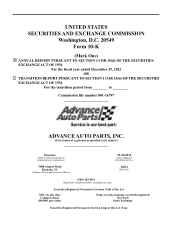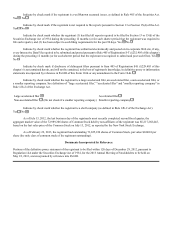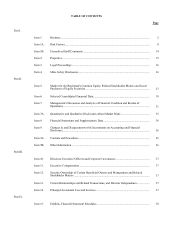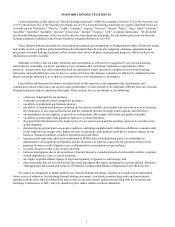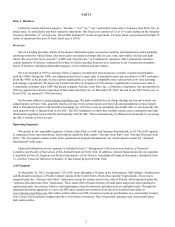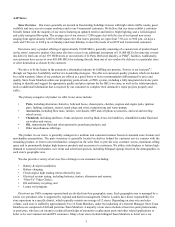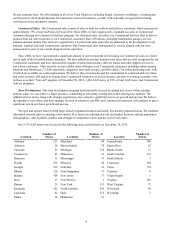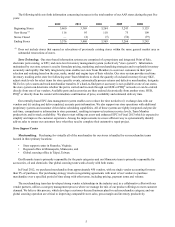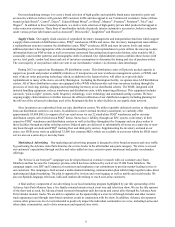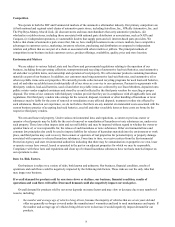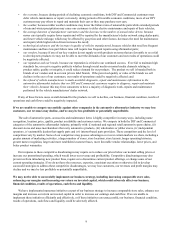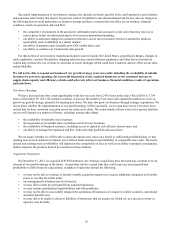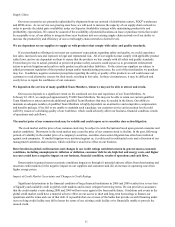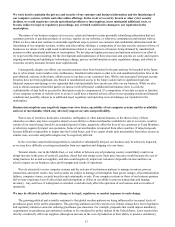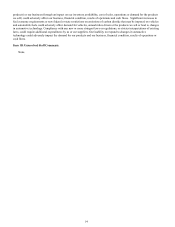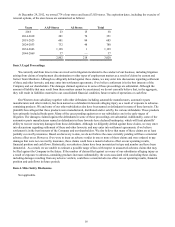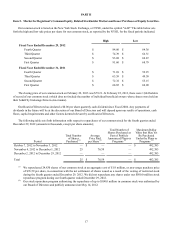Advance Auto Parts 2012 Annual Report Download - page 15
Download and view the complete annual report
Please find page 15 of the 2012 Advance Auto Parts annual report below. You can navigate through the pages in the report by either clicking on the pages listed below, or by using the keyword search tool below to find specific information within the annual report.8
Competition
We operate in both the DIY and Commercial markets of the automotive aftermarket industry. Our primary competitors are
(i) both national and regional retail chains of automotive parts stores, including AutoZone, Inc., O'Reilly Automotive, Inc. and
The Pep Boys-Manny, Moe & Jack, (ii) discount stores and mass merchandisers that carry automotive products, (iii)
wholesalers or jobber stores, including those associated with national parts distributors or associations, such as NAPA and
Carquest, (iv) independent operators, (v) automobile dealers that supply parts and (vi) internet-based parts providers. We
believe that chains of automotive parts stores that, like us, have multiple locations in one or more markets, have competitive
advantages in customer service, marketing, inventory selection, purchasing and distribution as compared to independent
retailers and jobbers that are not part of a chain or associated with other retailers or jobbers. The principal methods of
competition in our business include customer service, product offerings, availability, quality, price and store location.
Environmental Matters
We are subject to various federal, state and local laws and governmental regulations relating to the operation of our
business, including those governing collection, transportation and recycling of automotive lead-acid batteries, used automotive
oil and other recyclable items, and ownership and operation of real property. We sell consumer products containing hazardous
materials as part of our business. In addition, our customers may bring automotive lead-acid batteries, used automotive oil or
other recyclable items onto our properties. We currently provide collection and recycling programs for used lead-acid batteries,
used oil and other recyclable items at substantially all of our stores as a service to our customers. Pursuant to agreements with
third party vendors, lead-acid batteries, used oil and other recyclable items are collected by our Team Members, deposited onto
pallets or into vendor supplied containers and stored by us until collected by the third party vendors for recycling or proper
disposal. The terms of our contracts with third party vendors provide that they are in compliance with all applicable laws and
regulations. Our third party vendors who arrange for the removal, disposal, treatment or other handling of hazardous or toxic
substances may be liable for the costs of removal or remediation at any affected disposal, treatment or other site affected by
such substances. Based on our experience, we do not believe that there are any material environmental costs associated with the
current business practice of accepting lead-acid batteries, used oil and other recyclable items as these costs are borne by the
respective third party vendors.
We own and lease real property. Under various environmental laws and regulations, a current or previous owner or
operator of real property may be liable for the cost of removal or remediation of hazardous or toxic substances on, under or in
such property. These laws often impose joint and several liability and may be imposed without regard to whether the owner or
operator knew of, or was responsible for, the release of such hazardous or toxic substances. Other environmental laws and
common law principles also could be used to impose liability for releases of hazardous materials into the environment or work
place, and third parties may seek recovery from owners or operators of real properties for personal injury or property damage
associated with exposure to released hazardous substances. From time to time, we receive notices from the Environmental
Protection Agency and state environmental authorities indicating that there may be contamination on properties we own, lease
or operate or may have owned, leased or operated in the past or on adjacent properties for which we may be responsible.
Compliance with these laws and regulations and clean up of released hazardous substances have not had a material impact on
our operations to date.
Item 1A. Risk Factors.
Our business is subject to a variety of risks, both known and unknown. Our business, financial condition, results of
operations and cash flows could be negatively impacted by the following risk factors. These risks are not the only risks that
may impact our business.
If overall demand for products sold by our stores slows or declines, our business, financial condition, results of
operations and cash flows will suffer. Decreased demand could also negatively impact our stock price.
Overall demand for products sold by our stores depends on many factors and may slow or decrease due to any number of
reasons, including:
• the number and average age of vehicles being driven, because the majority of vehicles that are seven years old and
older are generally no longer covered under the manufacturers' warranties and tend to need maintenance and repair. If
the number and average age of vehicles being driven were to decrease it would negatively impact demand for our
products.


